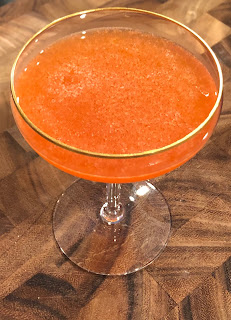Another in the annals of lesser known siblings of more famous cocktails, the Old Pal is a clear riff on the Boulevardier that didn't quite make it into the big leagues. First printed in Harry McElhone’s ABC of Mixing Cocktails, it dries out the more well-known version while retaining the same basic proportions.
Old Pal
1.25 oz rye whiskey
Old Pal
1.25 oz rye whiskey
1 oz dry vermouth
1 oz Campari
Combine all ingredients, stir with ice for fifteen seconds, then strain into a chilled cocktail glass and garnish with a lemon twist.
The aromas lead with sweet fruit from the Campari, vegetal spices from the rye, and lemon from the garnish. The sip opens with big Campari and rye sweetness up front, gets rather fruity in the middle, then fades out through dry vermouth and prickly rye spices. The finish is rather dry from the vermouth and Campari bitterness, gently accented by the rye.
Is there a Negroni/Boulevardier style drink that isn't good? If there is, I haven't found it yet. This one is another win and possibly one of the first published references to Campari in a cocktail recipe (according to Old Man Drinks). I can also see this working with Bruto Americano if you want to lean into the rye or Luxardo Bitter if you want to take it in a sweeter vanilla direction. You could also soften it with blanc vermouth instead of dry, but that would be a more radical change to the profile and bring it back somewhere closer to a rye Boulevardier. However you choose to construct it, this is clearly a winner.
1 oz Campari
Combine all ingredients, stir with ice for fifteen seconds, then strain into a chilled cocktail glass and garnish with a lemon twist.
The aromas lead with sweet fruit from the Campari, vegetal spices from the rye, and lemon from the garnish. The sip opens with big Campari and rye sweetness up front, gets rather fruity in the middle, then fades out through dry vermouth and prickly rye spices. The finish is rather dry from the vermouth and Campari bitterness, gently accented by the rye.
Is there a Negroni/Boulevardier style drink that isn't good? If there is, I haven't found it yet. This one is another win and possibly one of the first published references to Campari in a cocktail recipe (according to Old Man Drinks). I can also see this working with Bruto Americano if you want to lean into the rye or Luxardo Bitter if you want to take it in a sweeter vanilla direction. You could also soften it with blanc vermouth instead of dry, but that would be a more radical change to the profile and bring it back somewhere closer to a rye Boulevardier. However you choose to construct it, this is clearly a winner.















